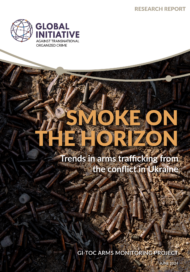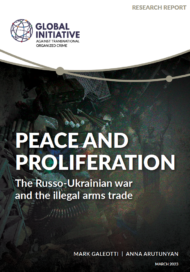Posted on 23 Sep 2024
Recent evidence shows early signs that organized arms trafficking is on the rise in Ukraine, marking a potential change from the Global Initiative Against Transnational Organized Crime (GI-TOC)’s latest report on the topic. Published in June 2024 and covering arms trafficking in 2023, the report focused on the proliferation of Russian ‘trophy’ weapons collected from the battlefield, mainly small arms and grenades that were sold in an ad hoc and organic manner without centralized criminal control.
But in June 2024, much heavier weapons were seized by Ukrainian law enforcement, including an anti-aircraft gun, a US machine gun and a high-end US automatic rifle carried exclusively by special forces. Significantly, it wasn’t civilians who were collecting discarded weapons and trying to sell them, but two active military personnel, neither of whom had a criminal record, according to a police report seen by the GI-TOC.
The most startling seizure was of the 23mm anti-aircraft gun, the Zu-23-2, which was being sold for US$7 500. Who would buy such a weapon remains unclear: its sheer size and capability would probably exclude it from most criminal arsenals, but it could be an option for terrorists or non-state armed groups. The weapon can be mounted on a truck and is capable of downing aircraft or destroying armoured vehicles.
The high-grade weapons seized in June commanded premium prices, bucking the overall trend. (Prices for AK weapons – a useful barometer – have fallen in Ukraine this year, from around US$1 000–1 500 in 2023 to US$1 000, according to GI-TOC sources.) The US-made M240 machine gun was offered for sale at US$8 000 and a Soviet-type AGS-17 automatic grenade launcher at US$6 000 – expensive, but a bargain for interested criminals, given the capabilities of such weapons.
Elsewhere, there are signs that the arms trafficking market is becoming more organized, with larger stockpiles being assembled. A September bust in Kyiv, for instance, saw the seizure of 132 rounds of ammunition for grenade launchers, among other weapons and ammunition. Its zone of operation is also expanding across the country – and closer to the EU border. In Lviv in August 2024, law enforcement broke up an arms trafficking ring and seized 72 pistols, 20 assault rifles, 29 grenades and almost 49 000 rounds of ammunition. The number of pistols is particularly striking, given that Ukrainian civilians cannot legally purchase handguns. This, together with their size, makes illegal handguns particularly coveted by criminals. Lviv is only about 70 kilometres from the Polish border and close to a number of regions in western Ukraine with long-established smuggling economies, such as Transcarpathia and Chernivtsi.
Alarming as they may be, the seizures also demonstrate Ukraine’s efficacy in disrupting arms trafficking. The importance of this should not be underestimated, given the plethora of competing priorities faced by the police, the security service and other agencies. For many reasons, not least the maintenance of good relations with the West over materiel support, tackling arms trafficking remains a high priority for Ukrainian law enforcement.
There have also been legislative developments. Since the publication of the GI-TOC’s report in June 2024, the Ukrainian parliament has adopted Law 9538 on ‘ensuring the participation of civilians in the defence of Ukraine’. The law aims, among other things, to regulate trophy weapons and their use, during and after the current period of martial law. Citizens will be allowed to keep the weapons they find, provided that the weapons are declared to the relevant authorities during the period of martial law. There is also provision for civilians to acquire legal ownership of some weapons after martial law ends: such weapons must be handed over to the police for inspection and, if deemed suitable, they will be returned after three months. This may be intended by the authorities as a ‘cooling off’ period, as some civilians are unlikely to return to claim weapons handed over for inspection.
However, some types of trophy weapons must be surrendered immediately, such as large-calibre firearms, machine guns, grenade launchers, flamethrowers and other heavy firepower, as well as any weapons belonging to state authorities. The law also prohibits the possession of ‘firearms and related that could become the means of committing a criminal offence’. Given that any weapon can be used to commit a crime, it remains unclear how this clause will be applied.
The law still needs to be signed by President Volodymyr Zelensky and then implemented by Ukraine’s Cabinet of Ministers and the relevant government and law enforcement agencies. The law is a significant milestone in addressing the issue and goes a long way towards providing regulatory guidance where none existed before. However, its wording may lead to operational ambiguity, as it allows the Ukrainian internal affairs ministry and law enforcement agencies a great deal of leeway in determining the law’s actual operational modalities. The absence of a fully functioning law on weapons possession in the country could also lead to legal consequences for those willing to surrender and legitimize their small arms.
Originally established to monitor the potential leakage of illegal arms from the conflict in Ukraine, the GI-TOC’s European Arms Monitor has expanded to cover arms trafficking throughout Europe and the wider region. The monitor will continue to track and provide updates on these developments.



